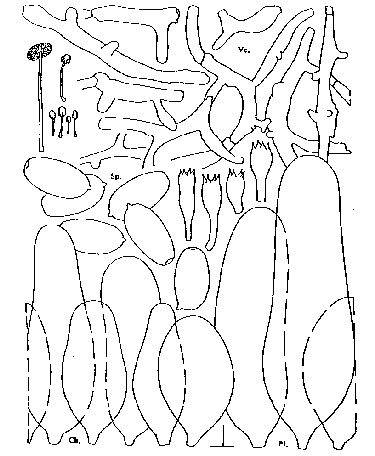Macroscopic features |
Pileus 2-7(-14) x 2-4(-8) mm when still closed, subglobose, ellipsoid or ovoid, white, often with clay-coloured or grey-cream centre; expanded pileus up to 8(-20) mm, greyish; veil radial hairy-floccose, whitish. Lamellae crowded, free, first whitish, then clay-coloured or greyish, finally violaceous black. Stipe up to 40 x 0.3-2(-2.5) mm, whitish, watery white, very fine floccose, more dense at base. |
Microscopic features |
Spores [100,5,3] 9.6-14.7 x 5.0-8.2 µm, oblong, mainly rounded at apex, dark red-brown, with central, 1.5-1.8 µm wide germ pore; Q = 1.62-2.15, av. Q = 1.80-1.95; av. L = 10.9-13.5, av. B = 5.9-7.5 µm. Basidia 18-32 x 8-10 µm, 4-spored, surrounded by (3-)4-6 pseudoparaphyses. Pleurocystidia 90-125 x 20-40 µm, cylindrical, utriform or ellipsoid. Cheilocystidia 60-100 x 22-40 µm, mainly utriform, a smaller number globose to ellipsoid or cylindrical. Elements of veil thin-walled, diverticulate, c. 30-100 x 2-10(-12) µm. Clamp-connections present. |
Habitat & distribution |
On old cow dung, solitary or a few together. Very rare. Not known from the Netherlands. Only a few collections are known to us from Europe. Two finds from Scotland (see original description), one from Italy and the species has been recorded by Bender (1991: 12) from Germany. |
Remarks |
Coprinus xenobius differs from the very closely related species C. luteocephalus in having slightly larger spores and smaller basidiocarps, less globose-ellipsoid but more utriform cheilocystidia and lack of yellow colours. The contrast in substrate preference (horse dung in C. luteocephalus versus cow dung in C. xenobius) does not seem to represent a reliable difference between the two taxa, especially when so little material is available. |

[Copyright © by ]

[Copyright © by Hans Bender jbe8995374@aol.com]